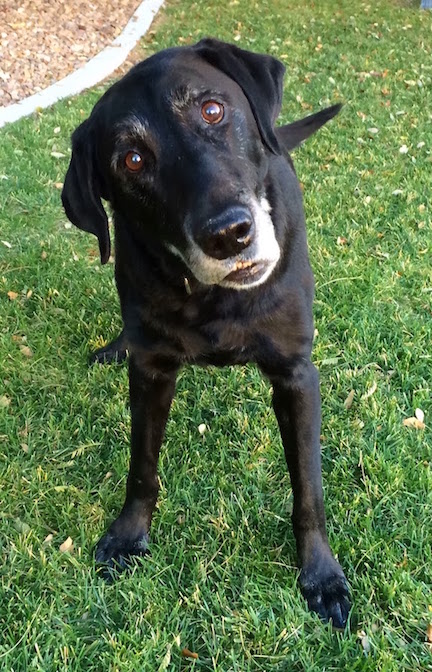Find Your Pet Through Facial Recognition Technology
John Polimeno, Finding Rover
 Millions of dogs are lost every year and only a small percentage ever return home. Finding Rover's goal was to rescue every lost dog. They made it easy, because if you saw a lost dog on the street, you just snapped a photo and their facial recognition technology would find the owner. When John Polimeno launched Finding Rover, within the first two weeks, seven lost dogs were found with this technology.
Millions of dogs are lost every year and only a small percentage ever return home. Finding Rover's goal was to rescue every lost dog. They made it easy, because if you saw a lost dog on the street, you just snapped a photo and their facial recognition technology would find the owner. When John Polimeno launched Finding Rover, within the first two weeks, seven lost dogs were found with this technology.
So how did it work? You downloaded the free app and registered your dog by taking a photo of it on your smartphone. When you took the photo, you were prompted to mark their eyes and nose. That was it, then your dog was registered.
Obviously, you needed a straight shot of your dog to make this work. So how did you get them to look at the camera phone? "That was one of our biggest problems, getting the dog to say cheese," Polimeno said. The problem was solved with a "bark button" that played recorded whining and barking to capture a pooch's attention.
But do dogs really look that different from each other? What about sibling dogs, did they look the same to the dog facial recognition system? Fortunately, the facial recognition system didn't know it was a dog. So you could actually put 100 German Shepherds in the database, put your own German Shepherd in the database, and yours would pop up in the top three 98-percent of the time.
Here is how the service worked:
* A dog owner registered his dog's photo on the Finding Rover website. There was a camera at the website, or you could download an existing photo. The recognition software okayed the photo or requested a reshoot.
* The pet's name, veterinary contact information, and other optional information was also added to the profile. Owners did not include their address or phone number.
* If the dog was lost, Finding Rover members could create a "digital dog poster" with the photo and contact information. Owners could also be contacted via a message through the platform. There was even an interactive map.
* Anyone finding a lost dog could likewise snap a photo and do a search. The digital dog poster came up when there was a match so the dog finder and dog owner could get Rover home. Owners of lost pets were notified when the website got a match, and then could contact the finder.
* Once the pet was been returned, the owner would then click that their dog was back home.
The idea for Finding Rover occurred during a coffee break at Starbucks. Looking at posters of lost pets reminded John of having lost his own dog, Harley. It was a wrenching experience as his family searched for their pet. Harley's story had a happy ending; he was at a neighbor's house.
This was also great for those times that you found a stray dog. You no longer had to grab them, put them in your car and take them to a vet and hoped they had a microchip. All you had to do is take their picture.
The Finding Rover App is no longer available, but don't worry, there are other apps that are doing this same exact thing.
Stories Behind Lost Cat Flyers
 Dr. Nancy Davidson, The Secret Of Lost Cats
Dr. Nancy Davidson, The Secret Of Lost Cats
You've seen them. Hanging on telephone poles and posted on supermarket bulletin boards. But have you ever wondered about the stories behind them?
When her orange tabby, Zak, disappeared, Nancy Davidson did what countless people before her had done. She made a lost cat poster.
Nancy received many calls after losing her cat. Unfortunately, while the callers didn't have any information to help her find her cat, they were positive and just wanted to wish her luck.
Nancy feels the reason so many people reached out, was because her lost poster was different. She actually drew a picture of a smiling orange cat and included phrases such as, "Is Friendly," "Will follow you," and "Acts Hungry."
After five days of frantic searching with no luck, Nancy decided to contact a physic. When she first contacted the psychic and asked her if she could find lost pets, there was just silence on the other end. Then, Nancy heard the click of a cigarette lighter and the inhalation of smoke. On the exhale, she heard, "He's alive… beautiful cat, orange, bushy tail… the neighborhood kid knows, a young boy."
Nancy immediately thought of the 10-year-old boy who lived next door. However, they were away for 10 days. Nancy then went next door and looked in the windows and saw her cat.
Nancy was ecstatic. Zak seemed happy too, although being a cat, it was hard to tell. Zak may have remained his old self, but Nancy had changed. From that moment on, she became aware of lost cat posters.
She studied their language, composition, and design. She was drawn to their folk art. Mostly, however, she was intrigued by the messages themselves, the stories behind the posters. It wasn't long before Nancy reached out to other owners of lost and found cats to offer empathy and support. They told hilarious and often poignant stories. They also sought advice.
What they told her, and what she learned, created a captivating look into the heart of our relationships with our pets and each other.
For seven years, Dr. Nancy followed the lost cat trail discovering answers to a question that eventually touches all of us: What will you do for love?
Nancy's book,The Secrets of Lost Cats, traces the evolution of her seven-year passion for lost cat posters.
 Dizzy Old Dogs - Diagnosing Idiopathic Vestibular Disease -Dr. Debbie
Dizzy Old Dogs - Diagnosing Idiopathic Vestibular Disease -Dr. Debbie
I came running when I heard the crashing paw steps of my 12-year-old Labrador, Magnum as he flopped and tumbled in a nervous frenzy. With head crooked to the right, Magnum's dizzy, wobbly movements resembled a carnival lover's exit from the tilt-a-whirl ride. His eyes darted back in forth in an uncontrollable movement. Many might assume Magnum suffered a stroke, and figured it was time to put the old guy to sleep. But fortunately there was hope - Magnum developed a typical case of Idiopathic Vestibular Disease.
What is Idiopathic Vestibular Disease?
Idiopathic Vestibular Disease, also known as Old Dog Vestibular Disease, is a condition commonly diagnosed in senior dogs, but also seen in cats. The term idiopathic basically means the cause is unknown. This condition affects the vestibular system and the pet's sense of balance, typically with a rapid onset of symptoms. In Magnum's case he literally was fine at the start of a television program, and was wobbly just one hour later.
Symptoms of Old Dog Vestibular Syndrome include a wobbly gait, head tilt, anxiety, panting, and an abnormal eye movement called nystagmus, a condition in which the eyes dart rapidly back-and-forth or up-and-down. In addition to mobility problems, the topsy-turvy sensation leads to nausea, vomiting, and an inability to eat or drink. Thankfully my sturdy stomached Labrador barely missed a meal during his bout.
The cause of idiopathic vestibular vestibular syndrome isn't completely known, but fortunately most dogs recovery from symptoms within 2 to 4 weeks. In some cases dogs may suffer from future bouts months to years later. Some dogs may retain a slight head tilt or unsteadiness at times.
What Can Be Done?
A veterinary examination is important to identify suspected cases of vestibular disease. Other possible causes of these symptoms could include an infectious or inflammatory condition, inner ear infection, cancer, or a brain vascular episode - a stroke-like episode. In order to rule out these potential causes, more detailed testing is needed and may include tests like a CT, MRI, and CSF tap.
 There isn't a cure for a vestibular episode, and some pets recover without any treatment. But other animals require supportive care including anti-nausea medications, intravenous fluid therapy, hand feeding, and physical assistance to walk and protect from household hazards.
There isn't a cure for a vestibular episode, and some pets recover without any treatment. But other animals require supportive care including anti-nausea medications, intravenous fluid therapy, hand feeding, and physical assistance to walk and protect from household hazards.
Caring for a frightened, disoriented, wobbly, nauseated dog can be difficult. My 80 pound Labrador needed physical support to get up, walk outside and required hand feeding at times. He couldn't be left home alone without risk of injury. And because of all the hoisting, blocking collisions with furniture, and guiding away from the depths of the pool, I injured my back during his rehab time. The reality is that home care of a small or toy breed with vestibular disease is much easier than the physical demands of a assisting a large or giant breed dog.
Lessons Learned
I have seen many a patient come to my veterinary office for euthanasia after developing similar vestibular symptoms. Some pet owners assume that the severe symptoms and rapid onset mean that there is no hope and euthanasia is the only choice. I'll admit that vestibular symptoms are scary and affected pets are tough to care for at home, but if given the tincture of time, many senior dogs will eventually improve. Perhaps Magnum's story will help other pet owner's opt to pursue treatment or testing, and give time a chance to heal.
Four weeks later and Magnum was back to playing with toys and energetically bounding on walks. He still retained a slight head tilt to the right, his badge of courage as I see it. I'm thankful for his recovery and adore his charming, lovable tilted perspective of the world.
Featured veterinarian known as "Dr. Debbie" on national pet radio program, Animal Radio. Ebook author of "Yorkshire Terriers: How to Be Your Dog's Best Friend"; "Pugs: How to Be Your Dog's Best Friend"; "Mini Schnauzers: How to Be Your Dog's Best Friend"; and "Shih Tzu: How to Be Your Dog's Best Friend." Dr. Debbie's books.
Visit Website
Animal Radio News with Stacey Cohen
 Vacationer Is "Horrified" After Eating A Rare Six-Legged Octopus
Vacationer Is "Horrified" After Eating A Rare Six-Legged Octopus
A man discovered a rare "hexapus" while snorkeling in Papa Nero, Greece. He killed the "hexapus" by smashing it on a rock and then took it to a local bar to cook it. When the tavern chef wouldn't fry up the octopus, the man took it back to where he was staying and cooked it himself. Afterward, he contacted a biologist who told him that the six-legged octopus was extremely rare. While he felt horrible about killing and eating the rarity, he said he simply thought, "It had just been born with six tentacles."
140-Pound Resident
Maine's north woods had a visitor that may have turned into a full-time resident. The visitor was a 140-pound black guinea hog. The animal and another hog were being hauled to slaughter when a trailer door opened during transit and the two got out. One hog was soon shot and slaughtered but the other porker lit out for the woods. The breed's talent for finding food, and a coat that can withstand cold weather, meant the pig could live out the next 20 years running free.
Proof of Bigfoot?
Two videos from Canada created a stir about the possible existence of Bigfoot. They showed large figures in the forest, but were too far away to be seen clearly. Dr. Jeff Meldrum wrote the book "Sasquatch: Legend Meets Science" and said he saw the videos. The videos out of British Columbia surfaced after a Canadian app company put out a request for images of Bigfoot, the Loch Ness monster and its Canadian cousin, Ogopogo. The company had an app called Legend Tracker, which dropped such creatures into real settings, but it was reported that the company did not have a hand with the user-submitted videos.
 Headaches Caused By Worm Inside Skull
Headaches Caused By Worm Inside Skull
A 60-year-old Chinese man had been suffering from nasty headaches and fainting fits for more than six months before he went to see a doctor. An X-ray of his head revealed a 6-inch-long parasitic worm inside his skull. We'll give you a moment to think about that. The man was admitted to the hospital to have it removed in a three-hour operation. The best part? He lived and was wormless. The worst part? When doctors removed the terrifying parasite and put it in a container of water, it started swimming around.
Police Dog Ate Hamster During Animal Cruelty Investigation
Police in England were investigating allegations of animal cruelty against a man, when a police dog with no understanding of irony ate the man's hamster. Despite the dog being forced to cough it up, the animal had died. An awkward pause no doubt followed before police resumed their bold crusade of animal protection. The man was charged with mistreating his parakeet and banned from bird ownership for two years.
 A Bear Wandered Into A Bar
A Bear Wandered Into A Bar
So a bear walks into a bar. It's not a joke; it really happened at a pub. The bear came in through the back door of the pub. Security camera footage showed the bear making its way past empty tables, then turning around and sauntering back outside. Patrons at the bar were completely oblivious to the animal. The bear received so much attention, a drink was named after him.
 Listen to the entire Podcast of this show (#1335)
Listen to the entire Podcast of this show (#1335)





